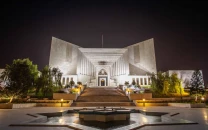Monsoon on the way: Plans chalked out for possible floods
UN officials say situation is worrisome because of a drop in funding for humanitarian efforts.

UN officials say situation is worrisome because of a drop in funding for humanitarian efforts. PHOTO: FILE
The expected monsoon rains are likely to cause flooding in the country, and emergency plans are being prepared in this regard, officials informed The Express Tribune.
Chief meteorologist Muhammad Hanif said that from mid-June onwards, heavy rain is expected across the country along with thunderstorms and lightning, particularly in the northern and northeastern areas including Islamabad and Azad Kashmir.

Keeping this challenge in view, Pakistan’s flood response organisations, civil society, and the National Disaster Management Authority (NDMA) in collaboration with senior UN relief officials have started devising an emergency plan in case catastrophic flooding occurs. Monsoon rains and consequent flooding had killed over 400 people in 2012.
A UN official, while talking to The Express Tribune said: “Different UN wings functioning in Pakistan have called for additional funds for Pakistan as the country is heading into the monsoon season, which usually results in flooding.”
“Precautionary measures are needed to meet emergencies when the monsoon enters the Asian region,” he said.
Earlier this week, Director of Operations John Ging at the UN Office for the Coordination of Humanitarian Affairs (OCHA) said that the situation in Pakistan was worrisome because of a drop in funding for humanitarian efforts.
On the other hand, NDMA’s risk reduction team member Idrees Mehsud said that the authority was constantly in contact with key state departments that could help overcome flood dangers. “After analysing the previous years experience we keep upgrading our emergency response and devise contingency plans after coordinating with state organs.”
However, he added that the NDMA awaits a forecast from the meteorological office before plans are finalised.
Moreover, district coordinating officials will assign the responsibilities for rescue and relief operations. Those responsibilities include everything from locating rehabilitation sites for the displaced persons to the distribution of rations.
Forecast so far
Northeastern areas of Punjab including Lahore, Gujranwala, Jhelum, Sialkot and other adjoining cities can experience heavy rainfall to very heavy rainfall between June 13 and June 15. Areas in South Punjab including Multan, Bahawalpur, Bahawalnagar and adjoining cities can experience rainfall during this period with thunder and lightning.
Rainfall may occur in Khyber-Pakhtunkhwa and Peshawar due to the interaction with western winds from June 13 to June 14, south Khyber Pakhtunkhwa and adjoining Balochistan can experience isolated heavy rainfall. In the northern and central areas, this first pre-monsoon spell might end on June 15 night or June 17 morning.
Published in The Express Tribune, June 16th, 2013.



















COMMENTS
Comments are moderated and generally will be posted if they are on-topic and not abusive.
For more information, please see our Comments FAQ